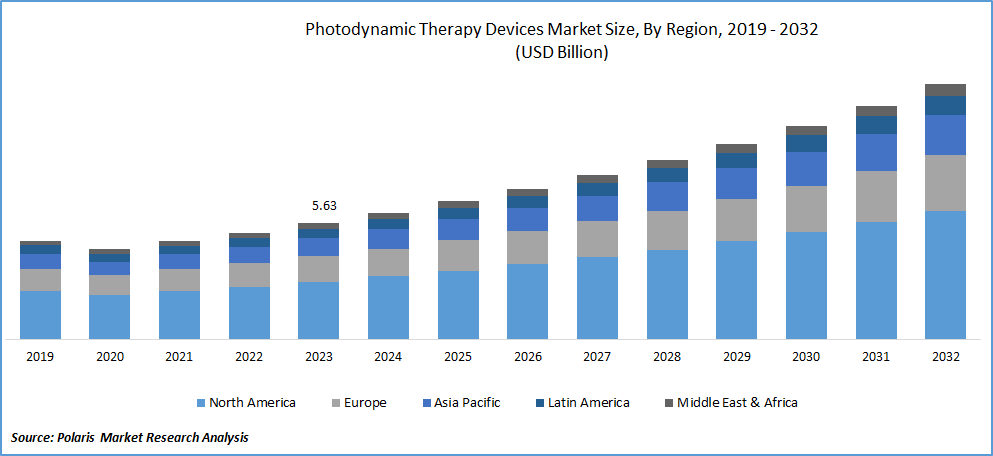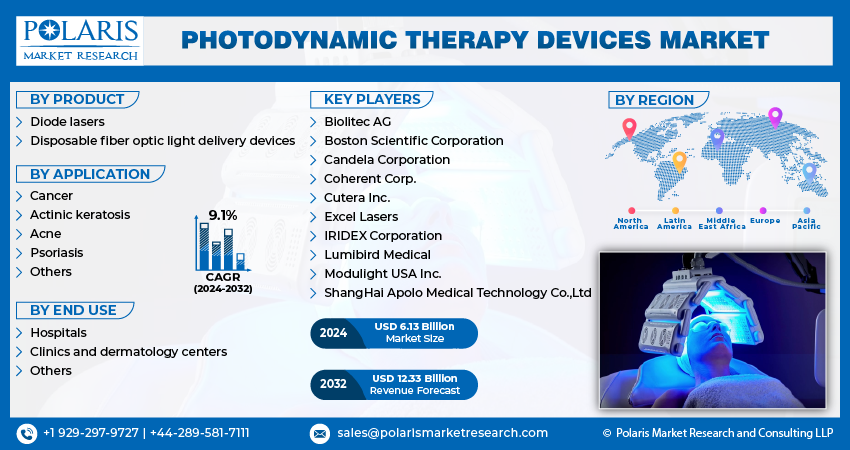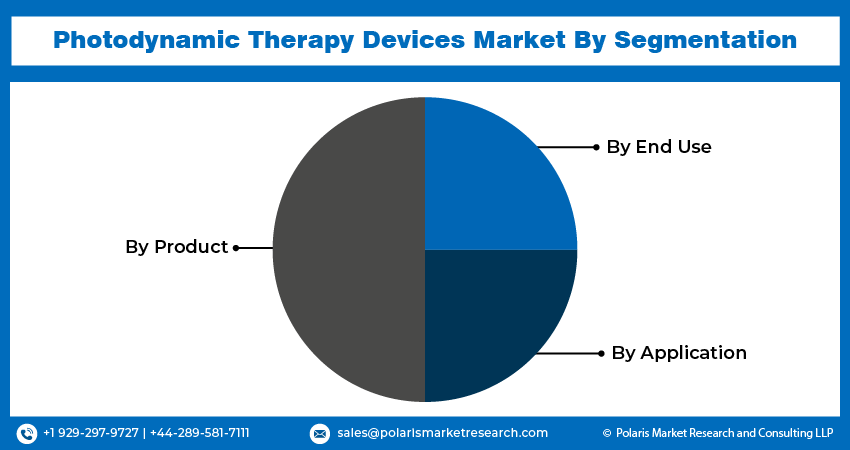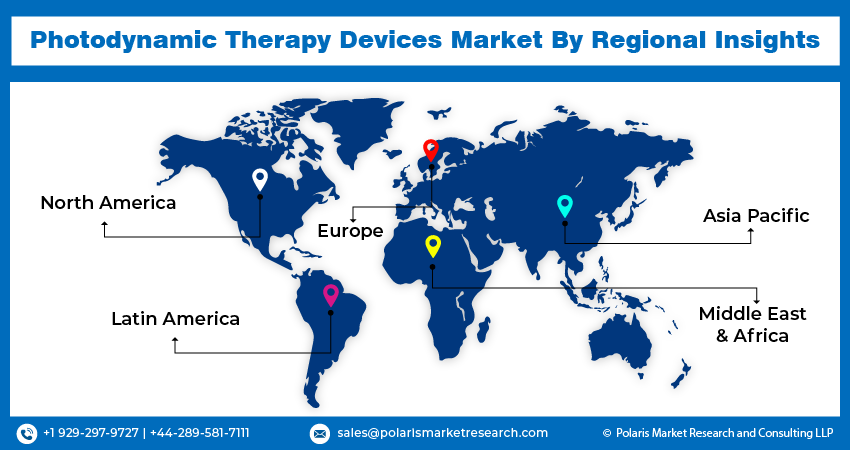
Photodynamic Therapy Devices Market Share, Size, Trends, Industry Analysis Report, By Product (Diode Laser and Disposable Fiber Optic Light Delivery Devices); By Application; By End Use; By Region; Segment Forecast, 2024- 2032
- Published Date:Mar-2024
- Pages: 117
- Format: PDF
- Report ID: PM4490
- Base Year: 2023
- Historical Data: 2019-2022
Report Outlook
Photodynamic Therapy Devices Market size was valued at USD 5.63 billion in 2023. The market is anticipated to grow from USD 6.13 billion in 2024 to USD 12.33 billion by 2032, exhibiting the CAGR of 9.1% during the forecast period
Industry Overview
Devices for photodynamic therapy (PDT) are medical tools used in photodynamic therapy treatment. PDT is a medical procedure used to treat a variety of illnesses, such as cancer and specific skin conditions. It involves the use of a photosensitizing agent, a light source, and oxygen.
With the rising demand for non-invasive and effective cancer treatments, companies are poised to address a critical need in the growing PDT Devices market. Investment and fundraising have been seen for further innovation and advanced technology in photodynamic therapy devices market. The funding will support ongoing clinical trials and studies that demonstrate the efficacy and safety of PDT. The increasing incidence of cancer, specifically squamous cell carcinoma and basal cell carcinoma of the skin, increases the need for efficient treatment alternatives such as photodynamic therapy.

To Understand More About this Research:Request a Free Sample Report
- For instance, in February 2022, as cancer rates continue to rise globally, the World Health Organization (WHO) reported that cancer was responsible for approximately 10 million deaths globally, or roughly one in six fatalities in 2020.
Furthermore, photosensitizing agent, a medication that activates in response to light, is given to the patient. This agent frequently targets particular tissues or cells. After a certain amount of time has passed to allow the photosensitizing agent to be absorbed by the targeted cells, a light source is applied to the area.
The light activates the photosensitizing agent, due to a chemical reaction that produces reactive oxygen species. The reactive oxygen species generated during the activation process cause damage to the targeted cells, either destroying them or affecting their functionality. This is particularly useful in treating certain types of cancer cells or abnormal skin cells result in the increasing demand for photodynamic therapy devices market during the forecast period.
Key Takeaways
- North America accounted for the largest market and contributed to more than 35% of share in 2023
- Asia Pacific is projected to grow at the fastest rate over the forecast period
- By application category, cancer segment accounted for the largest revenue share in 2023
- By End-use category, the hospital segment expected to witness the highest market share during the forecast period
What are the market drivers driving the demand for photodynamic therapy devices market?
- Increasing Prevalence of Cancer Patients
The increasing prevalence of cancer patients across the globe will facilitate market growth. Prevalence of various types of cancer is a major driver for the PDT Devices which is used in the treatment of certain cancers, and as cancer rates rise, the demand for effective treatment options like PDT is likely to increase. Ongoing technological innovations in medical devices, including PDT Devices, contribute to improved efficiency, safety, and efficacy. Innovations such as enhanced light sources targeted drug delivery systems, and real-time monitoring can drive market demand. The increasing demand for Photodynamic Therapy Devices anticipates the market share to grow during the forecast period.
PDT is considered a minimally invasive treatment compared to traditional therapies. As patients increasingly prefer less invasive procedures with quicker recovery times, the demand for PDT Devices may rise. Continuous research is expanding the applications of PDT beyond cancer treatment. The discovery of new applications, such as in dermatology and ophthalmology, can broaden the market and attract new users. This may result in increasing in photodynamic therapy devices market share.
Which factor is restraining the demand for Photodynamic Therapy Devices?
- Extended duration of therapy
Penetrating deep into tissues to target tumors can be challenging with certain types of light sources. Improving the depth of penetration without causing harm to surrounding tissues is an ongoing challenge in PDT. Navigating regulatory pathways for medical devices can be complex and time-consuming and require extended-duration therapy. Meeting regulatory requirements for safety and efficacy may delay market entry and increase development costs. However, a few obstacles impeding the market's expansion are the scarcity of drugs, the high expense of therapy, and stringent regulatory approvals. Furthermore, there are significant prospects for profit from continued research into extending PDT applications to treat ailments like pigmented lesions, acne, and age-related macular degeneration (AMD).

Report Segmentation
The market is primarily segmented based on product, application, end use and region.
|
By Product |
By Application |
By End Use |
By Region |
|
|
|
|
To Understand the Scope of this Report:Speak to Analyst
Category Wise Insights
By Application Insights
Based on application analysis, the market is segmented on the basis of cancer, actinic keratosis, acne, psoriasis, and others. In 2023, the cancer segment accounted for the largest revenue share. One major factor influencing this trend is cancer treatment; when it comes to cancer, photodynamic therapy is more advantageous than conventional therapies like chemotherapy or surgery.
The International Agency for Research on Cancer estimates that one in five people will obtain cancer at some significance in their lives and that one in eight men and one in eleven women will pass away from the illness. Furthermore, according to the Skin Cancer Foundation, one in five Americans will develop skin cancer by the time they are 70 years old, highlighting the rising cancer incidence brought on by increased exposure to UV radiation, resulting in an increase in photodynamic therapy equipment used and ultimately driving the market.
By End Use Insights
Based on end-use analysis, the market is segmented on the basis of Hospitals, Clinics der, dermatology centers, and Others. The hospital segment is expected to witness the highest market share during the forecast period. Based on End-use analysis, the market has been segmented on the basis of hospitals, Clinics, dermatology centers, and others.
The increasing incidence of cancer patients and also aesthetic lifestyle and skin treatment have been growing use of photodynamic therapy equipment. These motivating factors include the growing number of patients seeking non-invasive, effective treatment options for conditions like cancer and dermatological disorders, the increasing use of photodynamic therapy in hospital settings for a variety of medical conditions, and technological advancements in photodynamic therapy that make it the treatment of choice for hospital-based interventions. Furthermore, the hospital sector is distinguished by a high degree of infrastructure and experience, which makes it possible to carry out photodynamic therapy procedures effectively which is a major driver of the photodynamic therapy devices market growth as a result of the combination of these factors. Hence, the market share is anticipated to grow during the given forecast period.

Regional Insights
North America
North America accounted for the largest share of the PDT market due to the region's early adoption of PDT practices and high density of market participants. Notably, North America has claimed the largest revenue share in the global PDT market due to the widespread integration of advanced therapies, significant healthcare spending, rising cancer prevalence, and favorable reimbursement structures encouraging PDT adoption. Notably, the U.S. represents the largest PDT market in North America. This results in significant growth for the Photodynamic Therapy Devices Market in North America.
Asia Pacific
Asia Pacific is projected to grow at the fastest rate over the forecast period in the PTD market. This growth can be attributed to the region's increasing awareness of PDT as well as the rising incidence of skin conditions and cancer. Asia Pacific's top markets include China, India, and Japan. The market with the fastest growth trajectory is Asia Pacific. Increased investments in healthcare, especially in China and India, a large patient pool, and improved accessibility to healthcare are the main drivers of this growth.

Competitive Landscape
The market is characterized by intense competition, with established players relying on advanced technology and a strong brand image to drive revenue growth. These companies employ various strategies such as research and development, mergers and acquisitions, and technological innovations to expand their services portfolios and maintain a competitive edge in the market.
Some of the major players operating in the global market include:
- Biolitec AG
- Boston Scientific Corporation
- Candela Corporation
- Coherent Corp.
- Cutera Inc.
- Excel Lasers
- IRIDEX Corporation
- Lumibird Medical
- Modulight USA Inc.
- ShangHai Apolo Medical Technology Co.,Ltd
Recent Developments
- In April 2021, Lumeda Inc., a company specializes in PDT as an intraoperative adjuvant therapy for patients, announced that its Series A funding had concluded, allowing them to raise USD 4.3 million.
- As of August 2022, Asieris Pharmaceuticals declared the conclusion of the enrollment phase for its international Phase III Clinical Trial of Cevira (APRICITY). Cevira describes an innovative non-surgical approach to treating cervical high-grade squamous intraepithelial lesions (HSIL). This groundbreaking treatment involves a photodynamic drug-device combination product, leveraging the accumulation of a photosensitizer in the target cells.
Report Coverage
The photodynamic therapy devices market report emphasizes on key regions across the globe to provide better understanding of the product to the users. Also, the report provides market insights into recent developments, trends and analyzes the technologies that are gaining traction around the globe. Furthermore, the report covers in-depth qualitative analysis pertaining to various paradigm shifts associated with the transformation of these solutions.
The report provides detailed analysis of the market while focusing on various key aspects such as competitive product, application, end use and their futuristic growth opportunities.
Photodynamic Therapy Devices Market Report Scope
|
Report Attributes |
Details |
|
Market size value in 2024 |
USD 6.13 billion |
|
Revenue forecast in 2032 |
USD 12.33 billion |
|
CAGR |
9.1% from 2024 – 2032 |
|
Base year |
2023 |
|
Historical data |
2019 – 2022 |
|
Forecast period |
2024– 2032 |
|
Quantitative units |
Revenue in USD billion and CAGR from 2024 to 2032 |
|
Segments Covered |
By Product, By Application, By End use, By Region |
|
Regional scope |
North America, Europe, Asia Pacific, Latin America; Middle East & Africa |
|
Customization |
Report customization as per your requirements with respect to countries, region and segmentation. |
FAQ's
Photodynamic Therapy Devices Market report covering key segments are product, application, end use and region
Photodynamic Therapy Devices Market Size Worth $ 12.33 Billion By 2032
Photodynamic Therapy Devices Market exhibiting the CAGR of 9.1% during the forecast period.
Asia Pacific is leading the global market
The key driving factors in Photodynamic Therapy Devices Market Increasing Prevalence of Cancer Patient.
